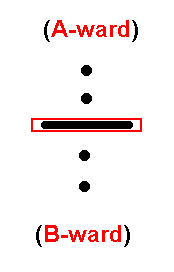

| Line perpendicular to the first dimension: stack-diagram form. |
| Line perpendicular to the first dimension: as arranged in physical reality. |
At the very beginning of Visualizing 4-space, the question of 4 lines lying at right angles to each other was posed. Ever since then, the material althroughout Visualizing 4-space could have been said to be working up to the present moment: before us lies a fourth line perpendicular to the three we are familiar with. In a very real sense, if you've portrayed a given number of lines lying at right angles to each other, you've succeeded in portraying a space of the same number of dimensions.
To show the 'relatedness' of the material, a Linelander's conception of a second line perpendicular to the one line he's familiar with is presented below. Displayed directly afterward is a Flatlander's conception of a third line perpendicular to the two lines he's familiar with - both presented in stack-diagram form. To the right of each stack-diagram is a portrayal of that stack-diagram as it would be arranged in physical reality - "all at once" - (and hence beyond the visualization capabilities of the given subject). To physically envision the line perpendicular to each dimension portrayed in each stack-diagram, imagine moving the cross-sections of that line over to their designated positions behind and in front of the central section of the stack-diagram.
This fourth line perpendicular to the three we are familiar with is portrayed in the manner we have come to conceive of a line perpendicular to the third dimension: in stack-diagram form. The line, in extending across the array of 3-planes, intersects each 3-plane at a point in its spatial center. In doing so, this line intersects the 3 perpendicular lines we are familiar with at the point at which they intersect each other. Take note that because we cannot experience this arrangement "all at once" (that is, as it occurs in physical reality) no attempt will be made to portray it this way. Rather, the reader is to conceive of this arrangement by imagining, as explained earlier, all of the slices of the stack-diagram as occupying the "same space" - our conception of 4-dimensional alignment.
We are fully aware of how 2 perpendicular lines meet, and of how 3 perpendicular lines meet. The lower-dimensional examples of these arrangements shown below, then, are presented not out of the intention to explain to us their configuration (which we are already aware of) but out of effort to boost the visualization capabilities we need to envision the coming together of 4 perpendicular lines. When dealing with 4-dimensional structures, you see, we are limited to 'stack-diagrams' - just as the Linelander and the Flatlander are in terms of dimensions above their own - and cannot visualize a fourth line perpendicular to the three we are familiar with beyond that level. That is, we cannot picture 4 perpendicular lines coming together as a single, undivided unit - we cannot experience a 4-dimensional structure in the way that it occurs "all at once" as it does in physical reality. What is to our advantage, however, is our ability to possess knowledge of lower dimensions that exists beyond the visualization capabilities of the Linelander and Flatlander. Because we can view the dimensions of the Linelander and Flatlander in ways that they cannot, we can apply this knowledge to our own dimension, in an attempt to construct in our minds models of 4-dimensional occurrences not confined to the limitations of a stack-diagram - models that do not have to be "chopped up" into an array of 3-planes to be understood, that one experiences, as stated, "all at once". To be able to do so would be to go beyond the limits of the third dimension in a way never done before.
It is upon observing the illustrations presented here, then, that one can agree that the representation of the fourth line perpendicular to the three we are familiar with, relates to the third dimension in the same way that the lower-dimensional examples relate to the dimensions with which they are associated.
 |
 |
|||||
|
|
|||||
 |
 |
|||||
|
|
|||||
 | |
|
Visualizing a fourth line perpendicular to the three we are familiar with is possible! If you've gotten this far you know this as a fact! Step by step we have witnessed that the fourth dimension is not as incomprehensible as we would be led to believe! What made this approach to the fourth dimension unique? This approach to the fourth dimension is unique in the sense that it involved no math whatsoever! As you are probably already aware, people tend to rely heavily upon mathematics when it comes to dealing with matters of the fourth dimension. Not so here. The tool of visualization used here was not math, but analogy: we assumed that what is true for lower dimensions must also be true for our own. It's that simple. The beauty of this approach is that it removes all unnecessary complication: we need not go about making guesses about what we think the fourth dimension may be, when the work is already done in the form of the spatial concepts observable in lower dimensions.
If you have any comments, questions, or feedback concerning Visualizing 4-space, do not hesitate to send a message to me through my ALL NEW e-mail account: [email protected]. However, this is not your only option. If you enjoyed Visualizing 4-space, you may want to progress onward to the topic that can be considered to be a continuation of where the concepts presented in Visualizing 4-space left off: the presentation of ideas found in Visualizing the Hypersphere. Having enjoyed Visualizing 4-space, you also have the option of looking through more of the topics presented in Thinking 4-D - a collection of several very readable selections written to present issues clearly and to stimulate the mind.
| to previous section |
to table of contents |
|